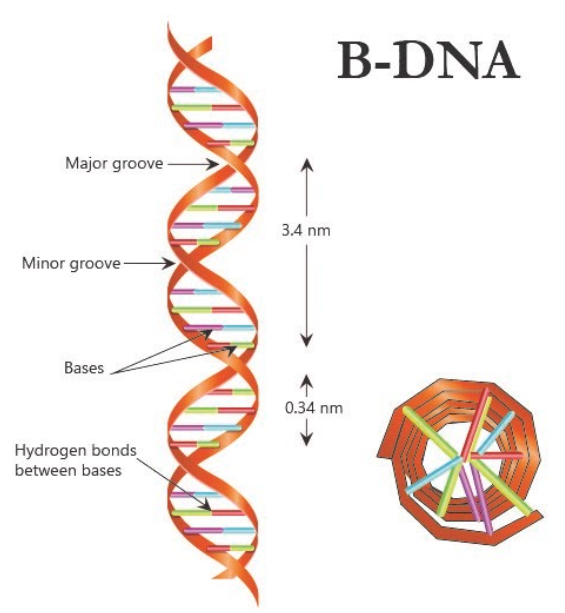
If the length of E.coli DNA is 1.36 mm, can you calculate the number of base pairs in E.coli?
Answer
460.2k+ views
Hint: DNA is a polymer that is made up of the repeating unit nucleotides. These nucleotides contain nitrogenous bases that pair with each other and are known as base pairs (bps). The DNA of Escherichia coli is double-stranded circular DNA.
Complete answer:
The length of DNA is usually represented in terms of the number of nucleotides (or a pair of nucleotides referred to as base pairs) present in it. The structure of DNA is such that between two consecutive base pairs, a distance of 0.34 nm (0.34×${ 10 }^{ -9 }$ m) is present. Thus, one can find the total length of a DNA of an organism by multiplying the total number of base pairs with a distance between two consecutive base pairs. Since we are given the length of the DNA of E.coli as 1.36 mm, we can divide this value by the distance between two consecutive base pairs to get the total number of base pairs present.
Total number of base pairs= 1.36mm/0.34x${ 10 }^{ -6 }$mm
Total number of base pairs= 4x${ 10 }^{ 6 }$ base pairs
Note: -In Escherichia coli, a clearly defined nucleus is not present, and thus the DNA is present in the cytoplasm of the cell and helps together with positively charged proteins in a region known as the nucleoid.
-The number of base pairs in Bacteriophage lambda is 48502 base pairs, in Bacteriophage $\phi $ ×174 is 5386 base pairs, and in a haploid cell of a human is 3.3 x ${ 10 }^{ 9 }$ base pairs.
-The length of DNA in a diploid human cell is calculated as 6.6 × ${ 10 }^{ 9 }$ bp × 0.34 × ${ 10 }^{ -9 }$m/bp, and it comes out to be approximately 2.2 meters.

Complete answer:
The length of DNA is usually represented in terms of the number of nucleotides (or a pair of nucleotides referred to as base pairs) present in it. The structure of DNA is such that between two consecutive base pairs, a distance of 0.34 nm (0.34×${ 10 }^{ -9 }$ m) is present. Thus, one can find the total length of a DNA of an organism by multiplying the total number of base pairs with a distance between two consecutive base pairs. Since we are given the length of the DNA of E.coli as 1.36 mm, we can divide this value by the distance between two consecutive base pairs to get the total number of base pairs present.
Total number of base pairs= 1.36mm/0.34x${ 10 }^{ -6 }$mm
Total number of base pairs= 4x${ 10 }^{ 6 }$ base pairs
Note: -In Escherichia coli, a clearly defined nucleus is not present, and thus the DNA is present in the cytoplasm of the cell and helps together with positively charged proteins in a region known as the nucleoid.
-The number of base pairs in Bacteriophage lambda is 48502 base pairs, in Bacteriophage $\phi $ ×174 is 5386 base pairs, and in a haploid cell of a human is 3.3 x ${ 10 }^{ 9 }$ base pairs.
-The length of DNA in a diploid human cell is calculated as 6.6 × ${ 10 }^{ 9 }$ bp × 0.34 × ${ 10 }^{ -9 }$m/bp, and it comes out to be approximately 2.2 meters.

Recently Updated Pages
Master Class 9 General Knowledge: Engaging Questions & Answers for Success

Master Class 9 English: Engaging Questions & Answers for Success

Master Class 9 Science: Engaging Questions & Answers for Success

Master Class 9 Social Science: Engaging Questions & Answers for Success

Master Class 9 Maths: Engaging Questions & Answers for Success

Class 9 Question and Answer - Your Ultimate Solutions Guide

Trending doubts
Types of lever in which effort is in between fulcrum class 12 physics CBSE

Which are the Top 10 Largest Countries of the World?

A two input XOR Gate produces a high output only when class 12 physics CBSE

What is a transformer Explain the principle construction class 12 physics CBSE

Differentiate between homogeneous and heterogeneous class 12 chemistry CBSE

Draw a labelled sketch of the human eye class 12 physics CBSE




